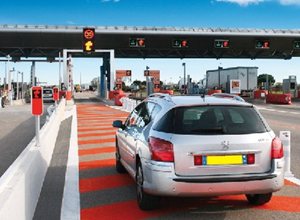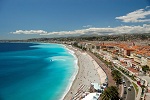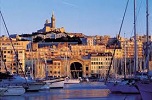Thankfully for the cash strapped motorist Britain has generally avoided the further financial burden of toll roads but anyone who has driven in France and Europe as a whole is likely to have encountered the péage motorway routes where, in exchange for your euros you can enjoy direct A to B motoring with reduced traffic and pothole free roads and even some of the
best driving roads in the World!

The challenge for the meaner Brit in the past has been how to get from the channel ports to the Loire or the South of France without paying but with time and fuel costs playing a big part in the decision, the toll roads are now getting a second look from even the tightest of travellers.
France’s autoroute network is extensive and doesn’t always incur a toll so on many routes, whilst you may have to pay some charges, their cost is evened out over the route. You’ll find further details in the links on this page.
History of Toll Roads in France
France was a latecomer to the idea of autoroutes and even later to the idea of toll roads, for at the time the country had 77km of freeways, Germany already had nearly 3,000km and even France’s first true autoroute from Saint Cloud to Orgeval was completed by the occupying Germans in the Second World War.
After the war little happened with the road network apart from necessary repairs but in the 1950s the government decided to implement a full autoroute plan financed from the public purse. This proved financially crippling so in 1955 the decision was made to change the proposed routes to toll roads and encourage private investment. Several companies sprang up to take advantage of the highly profitable business and by 1960 the autoroute system had doubled and by the end of the decade 1500km were in operation.
A movement in the 1980s by the socialist government to make all toll roads free of charge was defeated by MPs acting under pressure from the road transport groups and toll road companies and the preservation of the money-spinning system led to innovations such as electronic collection, auto bins and improved roadside facilities.
Today, whilst many may baulk at the cost, you can’t deny that the opportunity to reduce travelling times by up to 30% and fuel costs by the same amount, offsets the cost of up to 63 euros for the Rheims to Chamonix route. A necessary evil, they make motoring on the continent stress free, if a little dull.
Cost - How Much Do Toll Roads in France Cost?
Generally, you can expect the cost of toll roads in France to be around a euro for every ten miles of journey. The exact cost will vary depending on what part of the journey is on toll free roads as many of the state owned roads have remained as freeways. If you don’t want to pay the price of toll roads, there are the national roads which are toll free. There are many advantages and disadvantages to each and it really depends on how quickly you want to get to a destination; whether you are concerned more with saving money on fuel costs or tolls and whether you want a bland but quick journey or to see some of the many obscure sights of France.
Using Toll Roads
Advantages:
Disadvantages:
- You’ll get there quicker because traffic is lighter and the autoroutes are more direct and will have a higher speed limit.
- Maintaining an average speed saves on fuel consumption
- The roads are better maintained
- The cost of around a euro per ten miles/sixteen kilometres
- The routes avoid towns and cities so mostly you’ll just see concrete or tarmac and countryside for hundreds of miles
- Fuel prices are much higher on the autoroutes and service stations sell typically bland food and drink if you stop there for a break
Using Other Routes
Advantages:
Disadvantages:
- No charges for travelling on them
- Many will pass through villages, towns and cities meaning you can stop off and see some of France’s sights
- Fuel is cheaper in the towns and villages and you’ll find beautiful cafes and restaurants for a taste of regional French cuisine
- Driving will be much more interesting with less chance of becoming drowsy from the monotony of the route
- The journey time will be much longer as autoroutes are typically 10-20% shorter for journeys between A and B
- Fuel costs will be higher because of the extra distance and irregular travelling speeds
- Roads are less well maintained and there’s a greater chance of getting lost; even with a sat-nav
Sample routes and their costs:
- The A16 from Calais to Paris: 180 miles; €19.80 / Journey time approximately three hours
- Calais to Nice on several interlinking autoroutes: 760 miles; €102 / Journey time approximately eleven hours
- On the A10 from Paris to Bordeaux: 375 miles; €53 / Journey time approximately 5.5 hours
It’s possible to make savings on the toll charges with careful planning. Many of the national routes are free and of a similar standard to the autoroutes. For example, if you take the journey from Paris to Bordeaux but change onto the N10 at Poitiers you’ll save €15 in toll fees but only increase your journey length by 20 minutes and 11 miles.
Choosing the most direct routes also helps; from Calais to Toulouse via Paris is €20 more expensive than via Rouen. If you have a sat-nav, you can choose routes that avoid toll roads or alternatively you could fly to your destination and hire a car there.
Selected Routes - Popular Toll Road Journeys in France
 Calais to Paris by Toll Road
Calais to Paris by Toll Road
Distance: 180 miles
Toll Roads Used: A16 or A26/A1
Toll Charges: €18.60 on the A16 or €21 on the A26/A1
Probably the most popular route in Northern France, this takes ferry passengers from Dover through Calais to the French capital. The A16 follows the coast down as far as Abbeville before turning inland to Amiens and onto Beauvais. On the outskirts of Paris, take the A115 then the A15 which leads you on to the Boulevard Peripherique. The alternative route, the A26 heads southeast to Arras where you join the A1 south into Paris.
 Calais to Nice by Toll Road
Calais to Nice by Toll Road
Distance: 760 miles
Toll Roads Used: A26, A5, A31, A6, A7, A8
Toll Charges: €102
To get from Calais to Nice, follow the A26 to Troyes then turn east on the A5 to Langres. The A31 takes you south to Dijon where you’ll join the A6 to Lyon changing to the A7 which takes you down to the coast at Marseilles. From there, the A8 heads east to Nice.
 Calais to Marseille by Toll Road
Calais to Marseille by Toll Road
Distance: 553 miles
Toll Roads Used A26, A5, A31, A6, A7
Toll Charges: €87
The Calais to Marseille route follows the same directions as the route to Nice but instead of turning onto the A8 for Nice, follow the signs into central Marseille.
 Le Havre to Bordeaux by Toll Road
Le Havre to Bordeaux by Toll Road
Distance: 321 miles
Roads Used A13, A28, A10
Toll Charges: €60
The route from Le Havre to Bordeaux is long; over 400 miles but because some of the toll roads are cheap and some free N routes are used to connect to the autoroutes, the toll charge totals only €60. Take the A13 towards Rouen before turning south onto the A28 which takes you through Le Mans to Tours. From Tours the A10 takes you into Bordeaux.
 Roscoff to Toulouse
Roscoff to Toulouse
Distance: 437 miles
Roads Used N12, A84, N137, A83, A10, A62
Toll Charges: €41.50
Follow the N12 to Rennes; this road is toll free and in many places is dual carriageway. It joins the N137, also an excellent road, leading to Nantes. The A83 is the first toll road you’ll encounter from Nantes to Niort where you need to join the A10 which goes all the way to Bordeaux. From there the A62 takes you to Toulouse.
Toll Roads in France by Region
Further Reading on Driving in France;